
The knowledge of conic sections can be traced back to Ancient Greece. Menaechmus is credited with the discovery of conic sections around the years 360-350 B.C.; it is reported that he used them in his two solutions to the problem of "doubling the cube". Following the work of Menaechmus, these curves were investigated by Aristaeus and of Euclid. The next major contribution to the growth of conic section theory was made by the great Archimedes. Though he obtained many theorems concerning the conics, it does not appear that he published any work devoted solely to them. Apollonius, on the other hand, is known as the "Great Geometer" on the basis of his text Conic Sections, an eight-"book" (or in modern terms, "chapter") series on the subject. The first four books have come down to us in the original Ancient Greek, but books V-VII are known only from an Arabic translation, while the eighth book has been lost entirely.
In the years following Apollonius the Greek geometric tradition started to decline, though there were developments in astronomy, trigonometry, and algebra (Eves, 1990, p. 182). Pappus, who lived about 300 A.D., furthered the study of conic sections somewhat in minor ways. After Pappus, however, conic sections were nearly forgotten for 12 centuries. It was not until the sixteenth century, in part as a consequence of the invention of printing and the resulting dissemination of Apollonius' work, that any significant progress in the theory or applications of conic sections occurred; but when it did occur, in the work of Kepler, it was as part of one of the major advances in the history of science.
This paper will investigate the history of conic sections in ancient Greece. We will examine the work of the aforementioned mathematicians relevant to conic sections, with specific attention given to Apollonius's text on Conic Sections.
It may seem odd to begin with these late figures, but the significance of Pappus and Proclus needs to be established early. While Pappus of Alexandria was a competent mathematician and geometer, we are interested here in his work as a mathematical commentator and historian of mathematics. Residing mainly in Alexandria, roughly 500 years after the likes of Euclid, Archimedes, and Apollonius graced the intellectual scene, Pappus wrote several commentaries on the works of many great mathematicians of the past (that is, of his past!). One of his most important contributions was his Mathematical Collection, an eight book series that included commentary and historical notes, as well as several original propositions and extensions of existing works. In Book VII, he discusses twelve treatises of the past which included Apollonius' Conic Sections, Euclid's Surface Loci, and Aristaeus' Solid Loci (Eves, 1990, p. 183-4). Pappus gives us great insight into the lives and works of Greek geometers. He had access to works which are now lost, and in addition to being a skilled mathematician in his own right, he provides a valuable link to ancient Greek geometry.
Proclus, who lived during the fifth century A.D., was also a notable mathematical historian. Like Pappus, he had access to original documentation of the mathematics of the Classical and Hellenistic eras that is no longer available. His Eudemian Summary is an invaluable source of information about early Greek mathematical work up to Euclid (Eves, 1990, pp. 74- 75). His authority will be called upon in this paper, particularly when examining the influence of Aristaeus and Euclid.
According to tradition, the idea of the conic sections arose out of the exploration of the problem of "doubling the cube". This problem, and the accompanying story, is presented in a letter from Eratosthenes of Cyrene to King Ptolemy Euergetes, which has come down to us as quoted by Eutocius in his commentary on Archimedes' On the Sphere and Cylinder, which appears in Heath. Eratosthenes told the king that the legendary King Minos wished to build a tomb for Glaucus and felt that its current dimensions - one hundred feet on each side - were inadequate.
(Heath, 1961, p. xvii)
Clearly, doubling every side will increase the volume by a factor of eight, not by the desired factor of two. Mathematicians worked diligently on this problem, but were having tremendous difficulty in solving it. A breakthrough of a kind occurred when Hippocrates of Chios reduced the problem to the equivalent problem of "two mean proportionals", though this formulation turned out to be no easier to handle than the previous one (Heath, 1961, p. xviii). Eratosthenes continued by mentioning the Delians, who had an interest in exactly the same problem of "doubling a cube". When they called upon geometers at Plato's Academy in Athens for a solution, two geometers found answers to the equivalent mean proportions problem. Archytas of Tarentum used "half- cylinders", and Eudoxus used "curved lines". These solutions, however, only gave demonstrations of the existence of the desired number as a geometrical quantity, but they could not actually construct the mean proportion mechanically, so they did not reach the point of practical application until Menaechmus, who he achieved it with considerable difficulty (Heath, 1961, pp. xvii-xviii).
The mention above of Hippocrates' mean proportions is of interest. What this means is that, given two lengths a and b, we find x and y such that a:x::x:y and x:y::y::b, or in modern notation a/x=x/y=y/b; if we denote this ratio by r, then r^3 = (a/x)(x/y)(y/b)=a/b, and as Hippocrates noted, that if the segment a is twice as long as the segment b, then the doubling of the cube would be solved using the length r. Needless to say, he did not have an algebraic notation able to support the argument in the form we have given it, and had to argue directly.
Continuing our analysis in modern terms, the continued proportion above yields the three following equations which we now know to describe conics:
Menaechmus was a pupil of Eudoxus, a contemporary of Plato (Heath, 1921, p. 251). Much of what we know about Menaechmus's work comes to us from the commentaries of Eutocius, a Greek scholar who discussed the works of many mathematicians of his and earlier times, including Menaechmus, Archimedes, and Apollonius. In his solutions, Menaechmus essentially finds the intersection of (ii) and (iii) (see Solution 1, below), and then, alternatively, the intersection of (i) and (ii) (see Solution 2, below). Menaechmus's proof deals with the general case of the mean proportions. Once we have this, we can take the special case a=2b to double the cube. Before giving these two solutions, it should be noted that Menaechmus did not use the terms "parabola" and "hyperbola" - these terms are due to Apollonius. Instead, he called a parabola a "section of a right-angled cone", and a hyperbola a "section of an obtuse-angled cone" (Heath, 1921, p. 111).


While it is apparent that Menaechmus utilized what later became known as conic sections, did he really have a construction involving a cone in mind when he solved the problem of doubling the cube? Heath argues that he did, for the following reason. In the same letter from Eratosthenes to Ptolemy mentioned above, Eratosthenes stated, in connection with a discussion of his own solution to the problem, that there is no need to resort to "cutting the cone in the triads of Menaechmus" (Heath, 1961, xviii). In addition to this quotation appearing in Eutocius' commentary on Archimedes, Proclus confirms that conics were discovered by Menaechemus (Heath, 1961, xix) ...
Now that we have seen how Menaechmus first applied the conic sections, one might wonder, "How did he think of obtaining these curves from a cone?". Though there is virtually no information on this question itself, intuition tells us that the keen observational skills of Greek mathematicians would be attracted to such shapes. It is likely that the first conic section noticed in nature would have been an ellipse. If one cuts a cylinder at an angle other than a right angle to its axis, the result is an ellipse. In fact, Euclid notes in his Phaenomena that a cone or cylinder cut by a plane not parallel to the base results in a section of an acute-angled cone which is "similar to a [shield]" (Heath, 1921, 125). A natural extension of this phenomena would by the cutting of a cone in a similar fashion. Then perhaps they moved the cutting plane so that it does not cut the cone completely. What types of curves result? How are each of their properties similar to the other sections? How are they different? This is a possible, and probably simplified, discussion of the flowing of ideas that led to the study of conic sections.
Neugebauer suggests that the origin of the concept is in the theory of sundials, since the sheaf of light rays involved in the design of sundials is a cone which is cut by the plane of the horizon in a hyperbola, and a portion of that hyperbola is then marked out on the sundial.
According to Geminus, the ancients revolved a right triangle about one of its legs to determine a cone. Additionally, only right cones were known. Of these right-angled cones, there are three types. Evidently the vertical angle at the top of the cone could be less than ninety degrees, more than ninety degrees, or exactly ninety degrees (Heath, 1921, p. 111). We will see later when we study Apollonius, that there is a fundamental difference in the types of cones he considers. The segment connecting the "top point" of the cone to the center of the circular base is always a right angle. Apollonius considers a more general form of the cone do not assume the right angle (Heath, 1961, p. 1). Returning the specialized cones from the account of Geminus, these cones were called acute-angled, obtuse-angled, and right-angled cones (not to be confused with right cones, which refer to the revolution of a right triangle). In addition to the two names for hyperbola and parabola given previously, an ellipse was known as a "section of an acute-angled cone" (Heath, 1921, p. 111).
Nothing is known of the methods used by Menaechmus's to deal with these curves (Cajori, 1924, p. 27). Heath discusses what he calls his "probable" method, based on the assumption that Menaechmus's constructions of his curves would likely be rather simple and direct, but instructive enough to demonstrate the salient properties. This will not be discussed any further. Fortunately we have extensive documentation of the treatises of later geometers, notably Appolonius, on the subject of conic sections.
We next come to the (again, lost) works of Aristaeus `the elder' and of the celebrated Euclid on conic sections. Since we do not have the original works by these two men on conic sections, our knowledge of them is derived from the comments of Pappus, whose writings are discussed in Heath, using a translation by Hultsch:
The four books of Euclid's conics were completed by Apollonius, who added four more and produced eight books of conics. Aristaeus, who wrote the still extant five books of solid loci connected with the conics, called one of the conic sections the section of an acute-angled cone, another the section of a right-angled cone and the third the section of an obtuse-angled cone.... Apollonius says in his third book that the `locus with respect to three or four lines' had not been completely investigated by Euclid, and in fact neither Apollonius himself nor any one else could have added in the least to what was written by Euclid with the help of those properties of conics only which had been proved up to Euclid's time; Apollonius himself is evidence for this fact when he says that the theory of that locus could not be completed without the propositions which he had been obliged to work out for himself. Now Euclid-regarding Aristaeus as deserving credit for the discoveries he had already made in conics, and without anticipating him or wishing to construct anew the same system, being moreover in no wise contentious and, though exact, yet no braggart like the other-wrote so much about the locus as was possible by means of the conics of Aristaeus, without claiming completeness for his demonstrations ... (Heath, 1961, pp. xxi-xxii)
Before discussing the implications of Pappus' words, we turn to Proclus to give us some insight into the concept of a "solid locus". He defines a locus to be "a position of a line or surface involving one and the same property" (Heath, 1961, p. xxxii). Loci are divided into two classes, "line-loci", and "surface-loci". Within the line loci are "plane- loci" and "solid-loci". Plane-loci are generated in a plane, like the straight line. Solid-loci are generated from a section of a solid figure, i.e. the cylindrical helix and the conic sections. Pappus makes a division of what Proclus calls the solid-loci. He breaks this category into "linear-loci" and "solid-loci", not to be confused with what Proclus calls solid-loci. Solid-loci, to Pappus, are sections of cones (parabolas, ellipses, and hyperbolas), and linear-loci are more complicated lines than straight lines, circles, and conic sections (Heath, 1961, p. xxxiii).
With this information, along with Pappus' passage, Heath drew several conclusions concerning the works of Euclid and Aristaeus concerning conic sections. First, Aristaeus' treatment of solid loci concentrated on parabolas, ellipses, and hyperbolas, i.e. he considered conics to be loci. Second, Aristaeus' treatise on solid loci came first, and contained more original ideas and theorems than did Euclid's. Pappus says that Euclid wrote about the basic theory of conic sections, targeting his propositions to prepare readers to analyze the solid loci of Aristaeus (Heath, 1961, p. xxxii). Along these same lines, Heath remarks that "Euclid's Conics was a compilation and rearrangement of the geometry of the conics so far as known in his time, whereas the work of Aristaeus was more specialized and more original" (Heath, 1921, pp. 116-7). Third, Aristaeus used the terms "section of right-angled, acute-angled, and obtuse-angled cone", the accepted names for these curves until Apollonius. Finally, The Conics of Euclid was superseded by Conic Sections by Apollonius.
In addition to the ideas above, a key to pull from the work of Aristaeus and Euclid is that they were a source upon which mathematicians based their work upon, or at least consulted. We will see this in action as we continue our discussion with Archimedes and Apollonius.
"No survey of the history of conic sections could be complete without a tolerably exhaustive account of everything bearing on the subject which can be found in the extant works of Archimedes" (Heath, 1961, p. xli). There is no substantiated evidence that he ever wrote an entire work devoted to conic sections, but his knowledge of the subject is obvious in the works we do have. Among the treatise Archimedes published was Quadrature of the Parabola, Conoids and Spheroids, Floating Bodies, and Plane Equilibrium. These works share a common thread-they require the extensive use of the properties of parabolas, Archimedes' specialty amongst the conic sections (Heath, 1921, p. 124).
Heath says that Euclid's Conics is the probable source from which Archimedes adopts basic principles of conics that he assumes without proof (Heath, 1921, p. 122). He uses the "old", pre-Apollonius names for the conic sections (i.e. section of an acute-angled cone = ellipse) (Heath, 1961, p. xlii). Before going on it is important to clarify his vocabulary. Diameters are what we consider to be the axes of the ellipse (both the major and minor). These two diameters are conjugate. The axis of a parabola is also called a diameter, and the other diameters are called "lines parallel to the diameter". The diameter of a hyperbola is the portion of what we consider the axis within the single-branched hyperbola (Archimedes consider the second branch to be part of the same curve). The center of the hyperbola was called the point in which the "nearest lines to the section of an obtuse-angled cone" (asymptotes) meet (Heath, 1921, p. 122).
Heath cites several assumptions Archimedes made on the basis of previous works by the likes of Euclid and Aristaeus. With reference to the central conics:
The nature of Archimedes' writings seems to be such that he only proves what is not reasonably obvious to a trained mathematician. What was obvious to Archimedes, however, does not always coincide with what is obvious to most people! By the same argument, the propositions that Archimedes does prove tend to be very difficult. Archimedes seemed to be less concerned with developing a complete, systematic treatment of the conics (which in any case was accessible in the now lost works of others), but rather with using what was already established and/or easily proved develop deep and challenging theorems. For this reason, this paper, while it has given a basic background of the assumptions and basic trends of Archimedes' study, will not examine the original proofs he gave.
Along with Euclid and Archimedes, Apollonius is the third member of the trio of great geometric minds of Ancient Greece. "It is no exaggeration to say that almost every significant subsequent geometrical geometric, right up to and including the present time, finds its origin in some work of these three great scholars" (Eves, 1963, 25). Only a small amount of information is known about the life of Apollonius. He was born in the city of Perga, in Pamphylia, which was is located in southern Asia Minor, now Turkey. The date of his birth again is agreed upon by both Eves and Heath to be approximately 262 B.C., that is, approximately 25 years after the birth of Archimedes. As a young man he traveled to Alexandria to study with the successors of Euclid. He flourished during the reign of Ptolemy Euergetes ("The Benefactor", 247-222 B.C.). He continued to be a recognized scholar during the reign of Ptolemy Philopator (222-205 B.C.). (Heath, 1921, 126). It is also known that he visited Pergamum, where he met Eudemus, to whom he dedicated the first two books of his Conic Sections (Heath, 1921, 126). The third through seventh books (and possible the eighth, which is lost) were dedicated to King Attalus I (241-197 B.C.), a fact which has helped historians estimate the years of his lifetime.
Four of Apollonius' eight books have come down to us in Greek. The eighth book is completely lost - we do not even have any knowledge of its contents. Books V-VII have reached us in an Arabic translation, whose date is debatable. Eves and Heath consider it to be a ninth century translation (Eves, 1990, p. 171). Cajori on the other hand writes of a 1250 translation, without any mention of the ninth century one (Cajori, 1924, 38). Two brothers from the family Muh, Ahmad and al-Hasan, first contemplated translating Conic Sections into Arabic during the ninth century. They almost lost interest due to the poor condition of their manuscripts. Ahmad received a copy of Eutocius' edition of Books I-IV and had them translated by Abi Hilal al-Himsi (died 883/4). He then gave a different manuscript of books V-VII to Thabit ibn Qurra (lived 826-901) to translate. Confirming Cajori's mention of the 1250 translation, Heath reports that in 1248, another translation was made by Nasir ad-Din (Heath, 1921, p. 127).
Apollonius opens each of his surviving books with a preface. The preface to Book I, which serves as a general preface for the whole series, and to Book V have been included in Appendix A. From the general preface we learn that the first four books of Conic Sections completed and formalized the previous work known to Apollonius at the time. According to Heath, Apollonius never claims the material covered in the first four books to be original, except for certain theorems in Book III, and the investigations in Book IV. What he does contend, however, is that his treatise is more complete and rigorous than previous works on the subject, which agrees with the comments of Pappus (Heath, 1961, p. lxxvii). Unlike most of the first four books, books five through seven covered new concepts which went beyond the "essentials". Heath states, The real distinction between the first four books and the fifth consists rather in the fact that the former contain a connected and scientific exposition of the general theory of conic sections as the indispensable basis for further extensions of the subject in certain special directions, while the fifth Book is an instance of such specialization; the same is true of the sixth and seventh books (Heath, 1961, p. lxxvi).
Before we examine individual propositions from Conic Sections, it might be appropriate to mention the origin of the names of the conic sections as we know them to be today. According to Eves, the terms "ellipse", "parabola", and "hyperbola" were adopted from early Pythagorean vernacular referring to the "application of areas" (the form of "geometric algebra" recorded in Euclid's Elements, Book II. When applying a rectangle to a line segment [by aligning one edge of the rectangle to the segment with one corner of the rectangle matching up with one endpoint], the "other" corner of the rectangle either fell short of, met exactly, or exceeded the end of the segment. These three cases were respectively called "ellipsis", "parabole", or "hyperbole". Eves shows how these terms were applied in a similar spirit to the conic sections by Apollonius in the following manner:
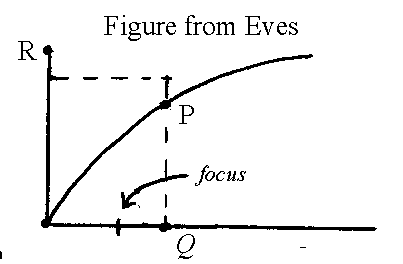
This argument alone does not seem to be a proof, or even a definition. As it is written, it certainly does not appear in Apollonius' Conic Sections, though, later, when his propositions are discussed, a similarity to these will be evident. Eves statements, however, do seem to check out when one follows the steps. The first three statements are clear, and common to all three cases. Not explicitly stated, let F be a focus of the given conic section, and K an endpoint of the latus rectum. Here are examples (non-Greek) of each of the three cases:
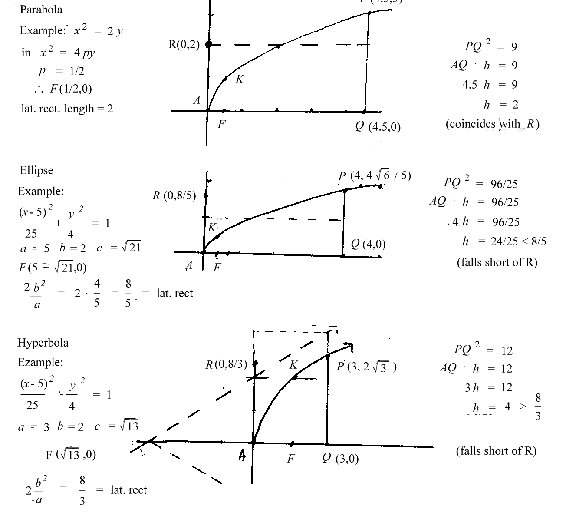
Before we go into Apollonius' method for proving these relationships, it would only be appropriate to start, as he did, by defining the relevant terms.
If a straight line indefinite in length, and passing always through a fixed point, be made to move round the circumference of a circle which is not in the same plane with the point, so as to pass successively through every point of that circumference, the moving straight line will trace out the surface of a double cone, or two similar cones lying in opposite directions and meeting in the fixed point, which is the apex of each cone.
The circle about which the straight line moves is called the base of the cone lying between the said circle and the fixed point, and the axis is defined as the straight line drawn from the fixed point or the apex to the center of the circle forming the base.
The cone so described is a scalene or oblique cone except in the particular case where the axis is perpendicular to the base. In this latter case the cone is a right cone.
If a cone be cut by a plane passing through the apex, the resulting section is a triangle, two sides being straight lines lying on the surface of the cone and the third side being the straight line which is the intersection of the cutting plane and the plane of the base.
Let there be a cone whose apex is A and whose base is the circle BC, and let O be the center of the circle, so that AO is the axis of the cone. Suppose now that the cone is cut by any plane parallel to the plane of the base BC, and DE, and let the axis AO meet the plane DE in o. Let p be any point on the intersection of the plane DE and the surface of the cone. Join Ap and produce it to meet the circumference of the circle BC in P. Join OP, op.
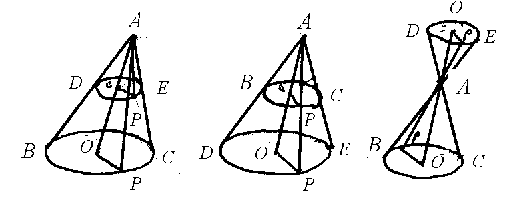
Then, since the plane passing though the straight lines AO, AP cuts the two parallel planes BC, DE in the straight lines OP, op respectively, OP, op are parallel.
And, BPC being a circle, OP remains constant for all positions of p on the curve DpE, and the ratio Ao : Ao is also constant.
Therefore, op is constant for all points on the section of the surface by the plane DE. In other words, that section is a circle.
Hence all sections of the cone which are parallel to the circular base are circles (Heath, 1961, pp. 1-2).
Conic Sections continues to define a diameter to be a straight line bisecting each of a series of parallel chords of a section of a cone. In each of the examples below, PP' is a diameter:

In the figures above, if QQ' is bisected by diameter PP' at V, then PV is called an ordinate, or a straight line drawn ordinate-wise. The length PV cut off from the diameter by any ordinate QV is called the abscissa of QV (Heath, 1961, pp. 7-8).
We now turn to Apollonius' definitions of the conic sections as we attempt to connect them to the definition Eves gave above. The case of the parabola will be given as an example of Apollonius' developments:
Proposition 1
First let the diameter PM of the section be parallel to one of the sides of the axial triangle as AC, and let QV be any ordinate to the diameter PM. Then if a straight line PL (supposed to be drawn perpendicular to PM in the plane of the section) be taken of such a length that PL:PA = BC² : BA.AC, it is to be proven that QV² = PL.PV
Let HK be drawn through V parallel to BC. Then, since QV is also parallel to DE, it follows that the plane through H, Q, K is parallel to the base of the cone and therefore produces a circular section whose diameter is HK. Also QV is at right angles to HK.

Now, by similar triangles and parallels,
Hence, QV² : PV.PA = PL : PA = PL.PV : PV.PA
QV² = PL.PV
It follows that the square on ay ordinate to the fixed diameter PM is equal to a rectangle applied to the fixed straight line PL drawn at right angles to PM with altitude equal to the corresponding abscissa PV. Hence the section is called a Parabola.
The fixed straight line PL is called the latus rectum, or the parameter of the ordinates.
This parameter, corresponding to the diameter PM, will be denoted by the symbol p below. Thus,
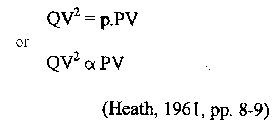
This proof differs from that given above, for the earlier exercise assumed the focus to be known. Apollonius chooses PL in such a way that it represents the latus rectum, or focal width of the curve. Due to the earlier development, that any plane parallel to the base and cutting the cone completely is a circle. Through the use of the sets of parallel lines QV and DE, HK and BC, and through the similar triangles HKA and BCA, it follows rather directly as Apollonius states. Just like in the previous demonstration (Eves), the square of the ordinate (QV²) is equal to the length of the latus rectum (PL) times the abscissa of QV (PV).
Apollonius' definitions of the hyperbola and ellipse follow along a similar line. For the hyperbola, the area of the rectangle (set equal to the square of the ordinate) overlaps the fixed latus rectum. For the ellipse, the area of the rectangle falls short of the fixed latus rectum. Reiterating from before, Heath suggests that these definitions indicate that the names come from the Pythagorean terms relating to the application of areas to segments.
The final topic of Apollonius' Conic Sections to be considered is his treatment of tangents. He develops this topic in both Book I and Book V. Book V introduces the idea of "maximum" and "minimum" lines to refer to tangents and normals, respectively. This book, considered by Eves to be "the most remarkable and original" of the seven we have today, quickly becomes very difficult to read and follow. The propositions and relationships it proves, which today are more easily shown using differential calculus, are rigorously explored in the classic Greek geometric fashion (Heath, 1961, pp. lxxv-lxxvi). Preliminary theorems, however, are not terribly difficult to follow. First we will look at two propositions from the first book concerning tangents (one will be stated and discussed, the other formally proved), and then we will look at one Book V theorem.
Proposition 11 states, If a straight line be drawn through the extremity of the diameter of any conic parallel to the ordinates to that diameter, the straight line will touch the conic, and no other straight line can fall between it and the conic (Heath, 1961, p. 22). That is, no straight line can fit between a tangent line and the curve to which it is tangent. This seems like a reasonable statement, related to the definition of tangent line used later in the development of the calculus (though, among other things, too "global" in scope).
Apollonius proves this in two cases, one for a parabola, and one for the ellipse, hyperbola, and circle [interesting that he would include the circle].
Proposition 12: If a point T be taken on the diameter of a parabola outside the curve and suh that TP = PV, where V is the foot of the ordinate from Q to the diameter PV, he line TQ will touch the parabola.
We have to prove that the straight line TQ or TQ produced does not fall within the curve on either side of Q.
For, if possible, let K, a point on TQ or TQ produced, fall within the curve, and through K draw Q'KV' parallel to an ordinate and meeting the diameter in V' and the curve in Q'.
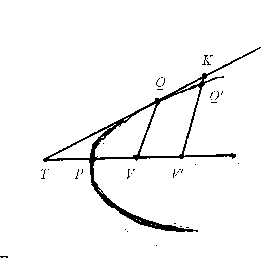
Then Q'V'² : QV² > KV'² : QV², by hypothesis, > TV'² : TV²
PV' : PV > TV'² :TV².
Hence, 4TP.PV' : 4TP.PV > TV'² : TV²
and, since TP = PV,
4TP.PV = TV²
4TP.PV' > TV'²
But, since by hypothesis TV' is not bisected in P,
4TP.PV' > TV'²,
which is absurd. Therefore, TQ does not at any point fall within the curve, and is therefore a tangent.
(Heath, 1961, p. 25)
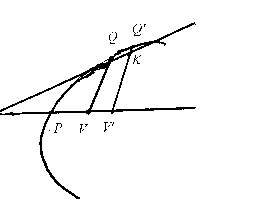
The figure for this proof by contradiction can be redrawn to show what is being assumed, that there exists a point K on TQ such that K lies inside the parabola. We then construct KQ'V' parallel to the ordinate QV.
Then, using our assumption that Q'V' > KV', the given TP = PV, and the similar triangles TVP and TV'Q', we arrive at the contradiction.
We now move ahead to Book V to get a feel for Apollonius' idea of minimum with a simple case of the concept:
Proposition 82 In a parabola, if E be a point on the axis such that AE is equal to half the latus rectum, then the minimum straight line from E to the curve is AE; and, if P be any other point on the curve, PE increases as P moves further from A on either side. Also, for any point:
PE² = AE² + AN²
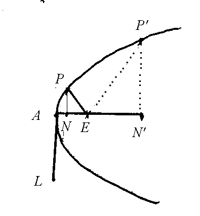
Let AL be the parameter or latus rectum. Then, PN² = AL.AN = 2AE.AN
Adding EN², we have, EN² = 2AE.AN + EN² = 2AE.AN + (AE - AN)² = AE² + AN
Thus, PE² > AE² and increase with AN, i.e. as P moves further and further from A. Also the minimum value of PE is AE, or AE is the shortest straight line from E to the curve.
(Heath, 1961, pp. 140-1)
[In this proposition, as well as many others in Book V, Apollonius considers three cases, where N is between A and E, where N coincides with E and PE (perpendicular to axis), and where AN is greater than AE-we will only consider this one case for brevity's sake]
The proof starts by stating the general relationship between the ordinate, abscissa, and latus rectum of a parabola. This is a special case of the parabola in which E is chosen on the diameter such that AE is half the latus rectum, which is reflected in the rewriting of the original relationship. Because PN is perpendicular to PE, EN² is added to both sides of the equation, and due to the Pythagorean Theorem, the left-hand-side of the equation reduces to PE². The rest of the proof follows easily.
This paper has attempted to provide a systematic introduction to the work of the Greek geometers involved in the development of conic section theory. It started with the work of Menaechmus, who first used conics to solve the doubling of the cube. It is unknown how many properties of the conics he knew, though it is generally accepted he did know they came from the cutting of a cone. After Menaechmus, Aristaeus and Euclid formalized and expanded upon the conics (Aristaeus was more original). Then came the great Archimedes, who used the elementary theory of conic sections to develop important concepts about parabolas, and extended that far beyond the scope of this paper. The culmination of the subject came at the hands of Apollonius, who, in eight volumes, rigorously developed all that was known about conic sections before him, and added a multitude of propositions that were original (we believe) to him, so much in fact that Eves notes, "The treatise is considerably more complete than the usual present-day college course in the subject".
After the era of these great mathematicians, there was a lull in the growth of conic sections until Pappus. He expanded upon much of what was known, and also proved to be a valuable source to modern math historians trying to learn about the Greek methods. With the passing of Pappus and perhaps Proclus, conics disappeared for over 1000 years until being re-born in the 15th and 16th centuries. Though the work of scientists and mathematicians, like Kepler who was both, conics evolved from a novel intellectual exercise in Ancient Greece, to a powerful modeling tool for explaining the physical laws of the universe.
APPENDIX A
Selected Prefaces to Conic Sectons (Translated by Halley, Printed in Heath)
Book I. General Preface
Apollonius to Eudemus, greeting.
If you are in good health and circumstances are in other respects as you wish, it is well; I too am tolerably well. When I was with you in Pergamum, I observed that you were eager to become acquainted with my work in conics; therefore I send you the first book which I have corrected, and the remaining books I will forward when I have finished them to my satisfaction. I daresay you have not forgotten my telling you that I undertook the investigation of this subject at the request of Naucrates the geometer at the time when he came to Alexandria and stayed with me, and that, after working it out in eight books, I communicated them to him at once, somewhat too huuriedly, without a thorough revision (as he was on the point of sailing), but putting down all that occurred to me, with the intention of returning to them later. Wherefore I now take the opportunity of publishing each portion from time to time, as it is gradually corrected. But, since it has chanced that some other persons also who have been with me have got the first and second books before they were corrected, do not be surprised if you find them in a different shape.
Now of the eight books the first four form an elementary introduction; the first contains the modes of producing the three sections and the opposite branches [of the hyperbola-Heath] and their fundamental properties worked out more fully and generally than in the writings of other authors; the second treats the properties of the diameters and axes of the sections as well as the asymptotes and other things of general importance and necessary for determining limits of possibility, and what I mean by diameters and axes you will learn from this book. The third book contains many remarkable theorems useful for the synthesis of solid loci and determinations of limits; the most and prettiest of these theorems are new, and, when I discovered them, I observed that Euclid had not worked out the synthesis of the locus with respect to three and four lines, but only a chance portion of it and that not successfully: for it was not possible that the synthesis could have been completed without my additional discoveries. The fourth book shows in how many ways the sections of cones meet one another and the circumference of a circle; it contains other matters in addition, none of which has been discussed by earlier writers, concerning the number of points in which a section of cone or the circumference of a circle meets [the opposite branches of a hyperbola-Heath].
The rest [of the books-Heath] are more by way of suplusage [`more advanced' but literally implies extensions of the subject beyond the mere essentials-Heath in the form of a footnote]: one of them deals somewhat fully with minima and maxima, one with equal and similar sections of cones, one with theorems involving determination of limits, and the last with determinate conic problems.
When all the books are published it will of course be open to those who read them to judge them as they individually please. Farewell.
Preface to Book V
Apollonius to Attalus, greeting.
In this fifth book I have laid down propositions relating to maximum and minimum straight lines. You must know that our predecessors and contemporaries have only superficially touched upon the investigation of the shortest lines, and have only proved what straight lines touch the sections and, conversely, what properties they have in virtue of which they are tangents. For my part, I have proved these properties in the first book (without however making any use, in the proofs, of the doctrine of the shortest lines) inasmuch as I wished to place them in close connection with that part of the subject in which I treated of the production of the three conic sections, in order to show at the same time that in each of the three sections numberless properties and necessary results appear, as they do with reference to the original (transverse) diameter. The propositions in which I discuss the shortest lines I have separated into classes, and dealt with each individual case by careful demonstration; I have also connected the investigation of them with the investigation of the greatest lines above mentioned, because I considered that those who cultivate this science needed them for obtaining a knowledge of the analyis and determination of problems as well as for their synthesis, irrespective of the fact that the subject of one of those which seem worthy of study for their own sake. Farewell.